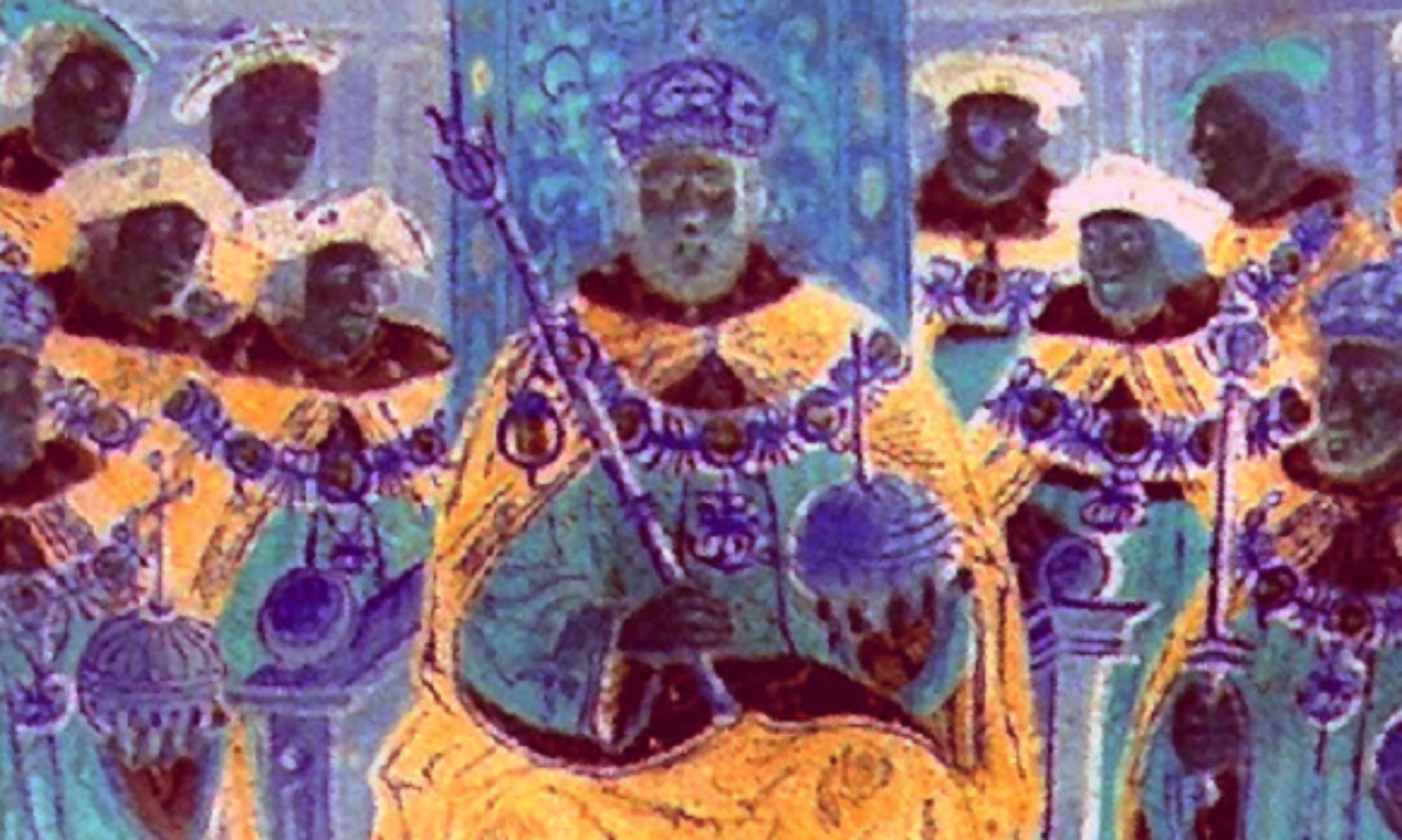Details on the Coronations of English Monarchs (1188–1490)
Below is a monarch-by-monarch account of coronations from Richard I (crowned 1189) through Henry VII (crowned 1485), including dates, locations, presiding clerics, and notable ceremonial details.
Richard I (“the Lionheart”)
- Coronation Date: 3 September 1189
- Location: Westminster Abbey
- Presiding Cleric: Baldwin of Exeter, Archbishop of Canterbury
- Ceremony Details: Richard processed from the Palace of Westminster to the Abbey, accompanied by a grand assembly of nobles and clergy. After the oath and anointing, Richard took the crown from the altar and handed it to the Archbishop, who crowned him. He changed to a lighter crown for the banquet in Westminster Hall. This is the first coronation with a detailed chronicler’s account.
John
- Coronation Date: 27 May 1199 (Ascension Day)
- Location: Westminster Abbey
- Presiding Cleric: Hubert Walter, Archbishop of Canterbury
- Ceremony Details: John was invested as Duke of Normandy before his English coronation. Chroniclers noted his “unseemly levity” and that he left before receiving Holy Communion.
Henry III
- First Coronation: 28 October 1216, Church of St. Peter in Gloucester (now Gloucester Cathedral)
- Presiding Cleric: Cardinal Guala Bicchieri or Peter des Roches, Bishop of Winchester
- Notes: Emergency coronation due to civil war and the king’s young age.
- Second Coronation: 17 May 1220, Westminster Abbey
- Presiding Cleric: Stephen Langton, Archbishop of Canterbury
- Notes: Formal ceremony to reinforce legitimacy.
Edward I
- Coronation Date: 19 August 1274 (Sunday)
- Location: Westminster Abbey
- Presiding Cleric: Robert Kilwardby, Archbishop of Canterbury.
Edward II
- Coronation Date: 25 February 1308 (Sunday)
- Location: Westminster Abbey
- Presiding Cleric: Henry Woodlock, Bishop of Winchester
- Ceremonial Note: The fourth recension of the coronation ordo was used, emphasizing the relationship between monarch and nobles.
Edward III
- Coronation Date: 1 February 1327 (Sunday)
- Location: Westminster Abbey
- Presiding Cleric: Walter Reynolds, Archbishop of Canterbury1.
Richard II
- Coronation Date: 16 July 1377 (Thursday)
- Location: Westminster Abbey
- Presiding Cleric: Simon Sudbury, Archbishop of Canterbury
- Ceremony Details: Featured a public procession from the Tower of London and elaborate ceremony. Richard was only 10 years old at the time.
Henry IV
- Coronation Date: 13 October 1399 (St. Edward’s Day, Monday)
- Location: Westminster Abbey
- Presiding Cleric: Thomas Arundel, Archbishop of Canterbury
- Ceremonial Note: First certain use of the Stone of Destiny at an English coronation12.
Henry V
- Coronation Date: 9 April 1413 (Passion Sunday)
- Location: Westminster Abbey
- Presiding Cleric: Thomas Arundel, Archbishop of Canterbury1.
Henry VI
- First Coronation: 6 November 1429, Westminster Abbey
- Presiding Cleric: Henry Chichele, Archbishop of Canterbury
- Second Coronation: 16 December 1431, Notre Dame de Paris (as King of France)
- Presiding Cleric: Henry Beaufort, Bishop of Winchester.
Edward IV
- Coronation Date: 28 June 1461 (Sunday)
- Location: Westminster Abbey
- Presiding Cleric: Thomas Bourchier, Archbishop of Canterbury.
Edward V
- Coronation: Not crowned; reigned April–June 1483 and disappeared before coronation could occur.
Richard III
- Coronation Date: 6 July 1483 (Sunday)
- Location: Westminster Abbey
- Presiding Cleric: Thomas Bourchier, Archbishop of Canterbury
- Ceremony Details: Included a grand procession, joint coronation with Queen Anne Neville, and a lavish banquet attended by the peerage.
Henry VII
- Coronation Date: 30 October 1485 (Sunday)
- Location: Westminster Abbey
- Presiding Cleric: Thomas Bourchier, Archbishop of Canterbury.
Common Elements of Medieval English Coronations
- Venue: Almost all coronations were held at Westminster Abbey, which has been the coronation church since 1066.
- Ritual Structure: The ceremony included recognition, oath-taking, anointing, investiture with regalia, crowning, enthronement, homage, and (if applicable) the crowning of a consort.
- Crowning: The Archbishop of Canterbury placed St Edward’s Crown on the monarch’s head, followed by acclamations of “God Save the King/Queen,” fanfares, and bell ringing.
- Homage: Senior clergy and nobles paid homage to the new monarch, swearing fealty and loyalty.
- Banquet: A grand banquet in Westminster Hall often followed the ceremony.
Summary Table
| Monarch | Coronation Date(s) | Location(s) | Presiding Cleric(s) | Notable Features |
|---|---|---|---|---|
| Richard I | 3 Sep 1189 | Westminster Abbey | Baldwin of Exeter | First detailed account; grand procession |
| John | 27 May 1199 | Westminster Abbey | Hubert Walter | Noted for “unseemly levity” |
| Henry III | 28 Oct 1216; 17 May 1220 | Gloucester; Westminster | Guala Bicchieri/Peter des Roches; Langton | Two coronations (emergency, then formal) |
| Edward I | 19 Aug 1274 | Westminster Abbey | Robert Kilwardby | |
| Edward II | 25 Feb 1308 | Westminster Abbey | Henry Woodlock | Fourth recension of coronation ordo |
| Edward III | 1 Feb 1327 | Westminster Abbey | Walter Reynolds | |
| Richard II | 16 Jul 1377 | Westminster Abbey | Simon Sudbury | Age 10; public procession |
| Henry IV | 13 Oct 1399 | Westminster Abbey | Thomas Arundel | First use of Stone of Destiny in England |
| Henry V | 9 Apr 1413 | Westminster Abbey | Thomas Arundel | |
| Henry VI | 6 Nov 1429; 16 Dec 1431 | Westminster; Notre Dame | Henry Chichele; Henry Beaufort | Crowned in England and France |
| Edward IV | 28 Jun 1461 | Westminster Abbey | Thomas Bourchier | |
| Edward V | – | – | – | Not crowned |
| Richard III | 6 Jul 1483 | Westminster Abbey | Thomas Bourchier | Joint coronation with Anne Neville |
| Henry VII | 30 Oct 1485 | Westminster Abbey | Thomas Bourchier | Start of Tudor dynasty |
This overview covers all English coronations from Richard I through Henry VII, reflecting the evolution of royal ritual, the importance of Westminster Abbey, and the enduring symbolism of the English crown.
